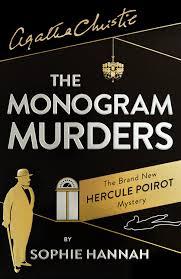 One of my favorite contemporary crime writers updates the work of one of my (and almost everyone else’s) vintage crime writers. What could possibly go wrong? In an absolute sense, nothing much. Sophie Hannah’s greatest strength is her tremendous ingenuity. She is celebrated for inventing the most fiendishly inventive and apparently insoluble scenarios and then going on to show how, in the end, they can be easily solved by the application of some brain power. Doesn’t that sound just like Christie too?
One of my favorite contemporary crime writers updates the work of one of my (and almost everyone else’s) vintage crime writers. What could possibly go wrong? In an absolute sense, nothing much. Sophie Hannah’s greatest strength is her tremendous ingenuity. She is celebrated for inventing the most fiendishly inventive and apparently insoluble scenarios and then going on to show how, in the end, they can be easily solved by the application of some brain power. Doesn’t that sound just like Christie too?
So here we have the Monogram Murders, as the series of bizarre crimes that are discovered at the beginning of the novel come to be called. It’s 1929. In a posh hotel in London’s West End, three people are found dead in separate hotel rooms. Each corpse proves to have in its mouth an identical monogrammed gold cufflink. The only link between the three, who have been generally thought to be at enmity with each other, is an event that took place some sixteen years ago.
Enter the great Belgian detective Hercule Poirot. He is accompanied here, not by his dear, foolish friend Captain Hastings, but by the equally naïve Inspector Catchpool, who is equally incapable of following Poirot’s train of thought, and stumbles along making mistakes and false assumptions and being reprimanded for doing so by Poirot. The two of them nose around London coffee houses and clubs, and interview vicars and aging widows in the country. A tissue of relationships is revealed, and love both requited and unrequited. There’s passion, jealousy, and the desire for revenge. Poirot speaks just like we expect him to – the little gray cells are referred to, he breaks into French (or rather Belgian) at moments of excitement or irritation, he has the well-known habits of over-fussiness we know so well, arranging his eating utensils in perfect order and refusing certain kinds of food and drink. He arranges for his suspects to sit together in a room while he slowly reveals the brilliant solution to the problem of the murder.
We are getting very used to – possibly slightly jaded with – the new wine in old bottles approach to detective fiction. We’ve had Jill Paton Walsh channelling Dorothy Sayers, William Boyd reviving James Bond, Benjamin Black recreating Philip Marlowe, Mike Ripley resuscitating Allingham’s Albert Campion – not to mention Sebastian Faulks bringing Jeeves back to life and more besides. All very good writers who’ve done pretty good jobs. And the same can be said about Sophie Hannah. Anyone who’s read everything by Christie and is feeling deprived will no doubt be delighted to find Poirot alive and well again. For me, though, much as I hate to say this, The Monogram Murders doesn’t quite make it. It’s a little too long, a little confusing in its astonishing ingenuity, a little unconvincing in its final denouement.
For all that, though, I wish the novel well. I hope it finds lots of readers and that they are less picky than I am. I won’t be put off Christie and I won’t be put off Hannah, whose novels I always seize upon while they are still hot off the press. I think the publishers did her a bit of a disservice here calling this ‘the literary event of the year’, but I’m still recommending it for both her fans and those of the great Christie herself.
